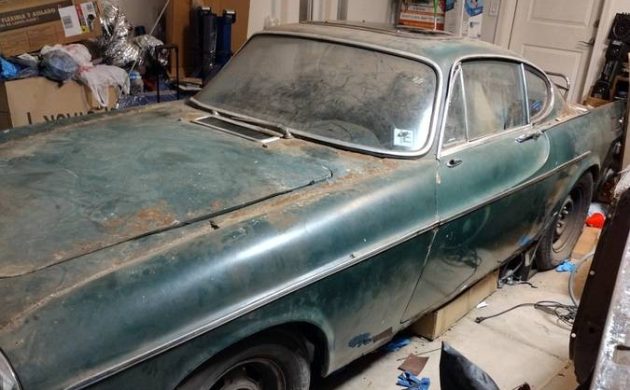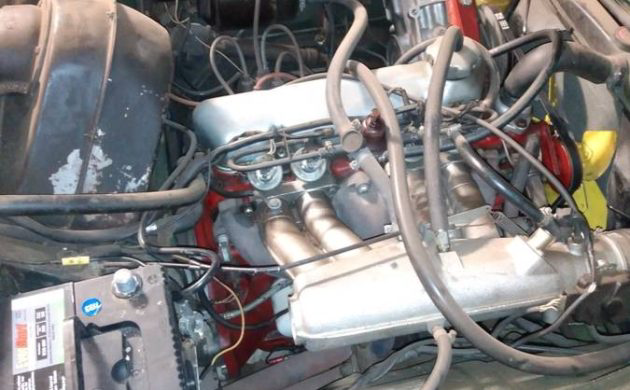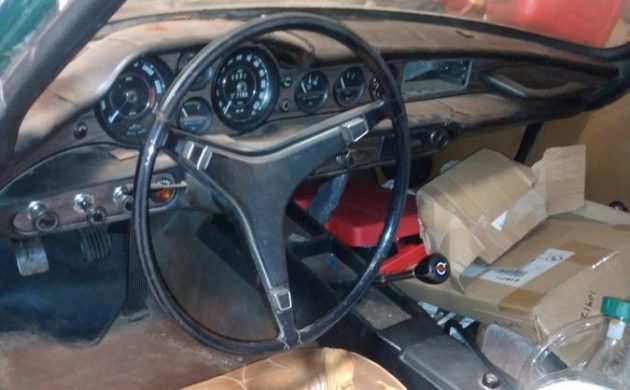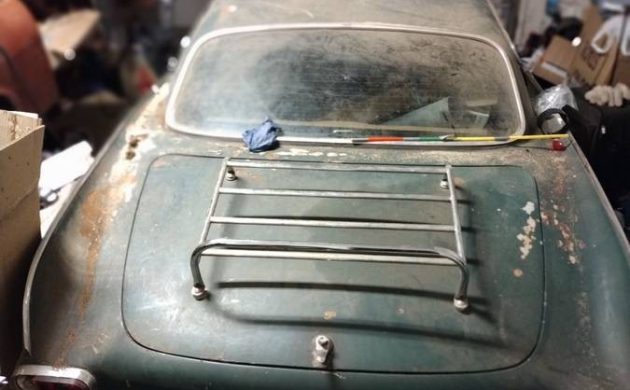Like many models conceived by many makers, Volvo’s P1800 only barely made it into existence. The near-demise of the lineage inspired by the Frua-built prototypes known as P958-X1, -X2, and -X3 was the fault of Volkswagen. The year was 1957, and Helmer Petterson – consultant to Volvo – had driven -X1 to Karmann to discuss producing the car. Volvo itself did not have the capacity, and Karmann was a willing and logical choice. Before negotiations were completed, however, Volkswagen forbade Karmann from taking on the project, convinced that the new Volvo would compete with VW’s own cars. When your primary customer puts its proverbial foot down, you listen, so Volvo was shown the door. But in a convoluted arrangement, Jensen Motors of West Bromwich, England, and Pressed Steel of Linwood, Scotland agreed to produce 10,000 P1800s. This lovely sporty car finally saw the light of day in the fall of 1960. Here on craigslist is a 1972 Volvo 1800E with an asking price of $10,000 located in Phoenix, Arizona.
The shambolic storage situation might make you believe the car has been neglected, but the seller says this 1800E has a new fuel pump and lines; the gas tank has been flushed; the coolant was replaced; the four-wheel disc brakes were inspected and it does run and drive! By 1972, Volvo’s four-cylinder displaced 1986 cc’s and had gained Bosch Jetronic fuel injection. The B20E type makes 130 bhp with a top speed of 118 mph but for the US market, emissions regulations demanded a lower compression ratio among other performance impediments. The downrated B20F engine makes about 107 bhp. The gearbox is a four-speed manual.
The garage has crept inside the cabin, with boxes and whatnot scattered about. Parts of the interior are respectable – the steering wheel, gauge faces. The dash is cracked, the driver’s seat has lost its upholstery. Someone installed an aftermarket sunroof, unfortunately. The trunk isn’t shot through with rust, and that looks like a new sending unit in the fuel tank.
The 1800 saw several design changes over its lifespan. Early Jensen-made cars have “horned” bumpers and the side trim swoops up across the door to meet the waistline at the bottom of the window. Later cars have straight bumpers and straight trim spears, though the indent that accepts the earlier curved piece remains part of the door bodywork. Grilles changed throughout production. I don’t care for luggage racks, and since this car needs paint, an enterprising owner could patch the sunroof, patch the trunk lid, and give it fresh paint. Values have risen for 1800s of all types, influenced by the 2019 sale of a very original ’72 for over $90k. While that may be a crazy price, it’s hard to find a project for much less than the ask on this example.











Between The Volvo education we got from Adam earlier this week and what we’ve here, Michelle, is this one of the models made by Jensen?
This one needs the interior from the one he talked about-and an owner that’s a little more enthusiasm in presentation, like, get it out, take out the superfluous junk inside and wash it off!!!
Maybe then they can talk about the price…
This is not a Jensen.
Jensen always use SU dual carburetor.
Jensen, always used the B18 engine and not the B20E. I know these vehicles very well.
Jensen are all P1800S.
I owned a Jensen 1965 P1800S.
Also owned two 2 1966 P1800S
And a 1971 P1800E w/automatic transmission.
Sorry Juan, the Jensen cars went from ’61 to ’63. Your ’65 would have been made in Sweden, not in England by Jensen.
The 1800s made by Jensen were the first 6000 cars from 1961-63. These are the “P” 1800s. Kudos to Michelle for not referring to this car as a P1800.
Jensen was contracted to make the first 10,000 cars, but Volvo wasn’t happy with the quality, so it pulled the plug on Jensen and brought production of the car to Sweden. The car was then referred to as the 1800S. In 1970, the car got fuel rejection, and became the 1800E. Ironically, the “lower quality” (but rarer) Jensen cars command higher prices than the Swedish-built cars.
These are fun cars. Not especially fast, and they handle OK, but not as nice as the BMW 2002, for example. I owned a 1969 1800s, and that car attracted more attention than any other classic car I’ve ever had. I swear I’ve seen babies in strollers with pacifiers in their mouths pointing at the car as I drove past.
Unfortunately, some joker who could not stop looking at his stupid I-Phone slammed into the car and it was totaled.
Thank you, Rex. Kinda strange, holding an inferior made model at the high water mark just because there were fewer made.🤔
On another note Too it’s sad to hear about a car you appreciated lost to you because of some twit won’t put their cell phone down-those kind of imbeciles can’t drive as it is; when their very limited IQ is split between the two spans of attention it fails miserably resulting in crashes like yours. However I for one am glad you were ok afterwards as you add some good info here!
The early cars have some jazzy styling details. The “cow horn” bumpers, for one, and that swoopy side trim. And it’s certainly not that the early cars are less reliable or tinny, they’re perfectly acceptable by most standards. Here’s a round up of styling changes – guaranteed to cure insomnia.
https://volvo1800pictures.com/wordpress/model-year-changes/
“Someone” commenting on Barn Finds about a year ago tutored me on the nomenclature of the 1800. Now I check twice!
And thank you for educating those of us that didn’t know what we didn’t know! The link you included has some fascinating details, like the “cow horns”-THREE horns with a control choose which to use? The info there in the link answers most of my above questions.👍🏻
Thank you for the link! I’m getting a better education of Volvo thanks to BF and you.
Rex
You are 100% correct.
It was my mistake & typing error ( S ) on Jenson. I did not own a Jensen, but 2 P1800S & 1 P1800E. However, my 1965 & 1966 had different Smith equipments on the dashboards not the immitation wood compare to the 1971. I did tried replacing the fuel injection to 2 SU carburetors but I need to plug some bolts holes in the engine. I should had bought a 1969. Instead of the 1971 which already came with the B20 engine.
Thanks my brother.
Another car I had the honor of experiencing. When I had my MGB, a good friend named Alex, had a green 1970. It was the 1st sports car I saw with fuel injection. Author says ’72 the 1st year, but his 1970 had F.I. and the author can add “Einspritzung”, meaning fuel injection, to her vocabulary, hence the P1800″E”. I can say with utmost respect, it was the nicest sports car I ever drove. Solid, great heat a/c, O/D, and plenty of power. It was no surprise to me, that the late Irv Gordon amassed an amazing 3.2 million miles on one, they were that good. Rust was the only thing that killed them.
1800e.
Aargh! So many cool cars, never enough time or space. And, yeah, moolah. A bucket list car, and this looks to be a good candidate!
the ES is the one to have (along w/a matching MGB GT or other early “sports hatch”). But…
No, yes, the stately + sporty ‘P1800’ sure isa great car. Ina way an early ‘world car’ w/4, 5 countries involved in bringing it about. Perfect look for Simon!
I had never heard that Karmann was approached about building the car, and I doubt that it is correct. I have never heard any other discussion about anything other than Pressed Steel being considered.
What I have read is that Ghia was first contacted about doing the design, after the failure of the fiberglass 1900, built by Glaspar in California. My understanding is this is where VW said “No.”
According to the mythology that I have read, the nice folks at Ghia suggested that they go next door to Frua……which at that point was owned by Ghia. Frua also had Pelle Petersen, son of a Volvo big wig, who just happened to be working there.
Volvo, for years, credited Pietro Frua for the design, but of late, has said it was actually Pelle Petersen.
In any case, the resemblance of the 1800 series Volvos to Ghia’s “Supersonic” prototypes for Fiat and Aston Martin is unmistakable, and clearly, the starting point for the final design for the car.
(BTW, it might have been me who made the correction! I’m glad you remembered. )
VW said no because the 1800 was competing with the Carmen Ghia.
I believe they told Ghia not to design a car for Volvo.
I do not believe that they told Karmann not to build one.